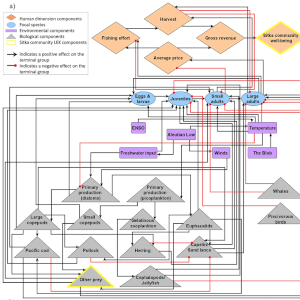An integrated ecosystem assessment (IEA) is a framework that organizes science to aid in the transition from traditional single-species management towards ecosystem-based management. Within the Gulf of Alaska, we started a small-scale IEA framework with active engagement of local stakeholders in the fishing community of Sitka. The initial step of this framework was the development of conceptual models. Here, we present a co-produced conceptual model using data gathered from participatory focus groups and a literature review of ecosystem attributes driving the abundance of sablefish (Anoplopoma fimbria). We then assembled a qualitative network model (QNM), a mathematical representation of a conceptual system in which perturbations of individual components can be assessed for their qualitative effect. Simulations were conducted to test different biophysical scenarios, while evaluating tradeoffs across ecological and human dimension components. In contrast to large adult sablefish, juvenile and small adults responded similarly to most biophysical conditions. In general, human dimension components responded negatively to the tested scenarios. These results highlight the potential need for management strategies that differentiate between small and large adults, particularly if current sablefish stock assessment trends persist, such as the lack of older fish contributing to spawning biomass and uncertainties in estimates of year-class strength.
Participatory place-based integrated ecosystem assessment in Sitka, Alaska: Constructing and operationalizing a socio-ecological conceptual model for sablefish (Anoplopoma fimbria)
Publication date
March 22, 2021
Abstract
Journal
Deep Sea Research Part II: Topical Studies in Oceanography
Region
Alaska


